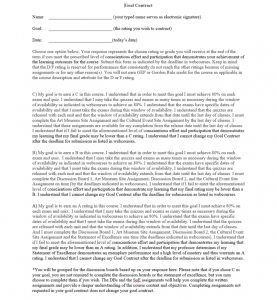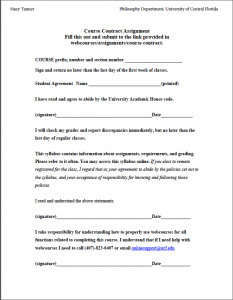Tags: Assessment, Course Organization, Course Protocol, Introduction
Description
It is very important to design an online course in a way that supports students to get started on the right foot (Chico, 2009). When a student starts an online course, they read the essential course information (syllabus, course expectations, instructor introduction) and learn about the course policies and expectations. Otherwise, miscommunications can happen due to a lack of understanding of the essential course information. To address this, one strategy is to create a Course Contract Assignment for your students to complete during the first week. This ensures that students have reviewed the essential course documents, e.g. syllabus, for the most important items. Also, if a student claims he or she was not aware of a policy, you can review the course contract assignment with the student. Additionally, another strategy that supports students during the start of a new course is a goal contract. These goal contracts can help alleviate student anxiety by helping the students to stay focused on their effort within the course from the start.
Link to example artifact(s)
Contract 1
Course Contract Assignment
Dr. Stacy Tanner from the University of Central Florida created a course contract assignment to help her students learn about course policies in her course. This course contract assignment was created for an undergraduate humanities survey course with sixty students. The assignment is a file that students must download and save with a unique file name (that includes his or her last name). They must then read each statement. Then each student must electronically sign by typing his or her name in each blank. The student will save the file again and proceed to upload the file to the designated submission link within the respective LMS. She used the course contract assignment in order to meet several goals for the first week of classes.
- First, like many institutions of higher education, student attendance is tracked early on in the semester (Center for Distributed Learning, 2015).
- Second, she wants to ensure her students understand key university, departmental, and course policies right out of the gate.
- Third, she wants her students to be comfortable submitting their assignment files electronically to the college or university’s learning management system (LMS).
- Finally, she wants my students to understand how they retrieve originality reports from the Turnitin system within the LMS system.
Below are her assignment instructions:
“Fill out this form with your information and then save the file. It is good practice to name the file with your last name when you save it. Then upload and submit it under the assignment submission link provided in the top right-hand corner. Once you completed the submission, you should take a screen shot of the accepted and successful submission of the assignment. It is good practice to always complete this action. In this way, you will always have documentation of submission. This exercise offers students practice with the submission process within Webcourses. It is always the student’s responsibility to ensure proper submission of paper assignments. This exercise also familiarizes students with the originality reports generated from the Turnitin system. You can see the originality report by clicking on the Turnitin icon. This assignment is required. Everyone must submit this form by the end of the first week of classes. This is the assignment that verifies your enrollment in the course and is required to adhere to university policy.”
Download a copy of Dr. Tanner’s course contract sample here: File:Course Contract Assignment.pdf.
Contract 2
Goal Contract Assignment
Student anxiety about grades can often overshadow learning opportunities. One potential response to alleviating anxiety and refocusing student attention on demonstrating learning is through the use of goal contracts, also know as grade contracts. It is possible to ease student anxiety by clearly define that grades will “be determined by your effort, what you do—on your conscientious effort and participation” (Elbow and Danielwicz 2).
The Goal Contract Assignment was created for a General Education Humanities course at the University of Central Florida using the GEP learning outcomes associated with the course. Professors may choose to alter this in ways that are most suitable for their university or college, discipline and course.
Below are her assignment instructions:
Your grade may be determined by your effort “what you do—on your conscientious effort and participation” (Elbow and Danielwicz 2). Conscientious effort and participation is defined through the follow activities that demonstrate your achievement of the learning outcomes:
- You will demonstrate your disciplinary specific knowledge through completing
 and earning 80% on quizzes and exams. You can take these assessments as many times as necessary during the window of availability as noted in Webcourses. (A, B, C)
and earning 80% on quizzes and exams. You can take these assessments as many times as necessary during the window of availability as noted in Webcourses. (A, B, C) - You will demonstrate the expansion of your understanding of diverse cultures through the analysis of cultural expressions through the completion of written assignments that include a clear analysis of cultural expressions and that cite referenced sources appropriately and according to the conventions of the discipline. (A, B, C)
- The timeliness of the submissions and the completion of discussion boards meant to help you plan your written assignments. (A, B)
- The effectiveness of your statement of excellence* (as applicable). (A) Elbow, Peter and Jane Danielwicz. “A Unilateral Grading Contract to Improve Leaning and Teaching.” College Composition and Communication. vol. 61 no. 2 2009. 244-268.
- *Ultimately, your instructor determines whether your statement of excellence warrants an A rating.Download a copy of Dr. Tanner’s goal contract assignment here: Goal ContractThese assignments were created for Canvas and may require edits based upon the LMS system used at your institution.
Link to scholarly reference(s)
Center for Distributed Learning (2015). UCF financial aid requirement. University of Central Florida. Orlando, FL. Retrieved from:
https://cdl.ucf.edu/teach-online/resources/financial-aid/
Chico. (2009). Rubric for online instruction. California State University, Chico. Retrieved from http://www.csuchico.edu/eoi/documents/rubricpdf
Elbow, P., & Danielwicz, J. (2009). A unilateral grading contract to improve leaning and teaching. College Composition and Communication. 61(2), 244-268.
Citation
Tanner, S. (2015). Create contracts to improve communication and reduce anxiety. In B. Chen & K. Thompson (Eds.), Teaching Online Pedagogical Repository. Orlando, FL: University of Central Florida Center for Distributed Learning. https://topr.online.ucf.edu/create-a-course-contract-assignment-to-help-students-learn-about-course-policies/.Post Revisions:
- August 7, 2020 @ 15:51:44 [Current Revision]
- August 7, 2020 @ 15:51:44
- August 2, 2019 @ 18:15:05
- July 20, 2018 @ 13:58:40
- July 5, 2018 @ 15:15:33


